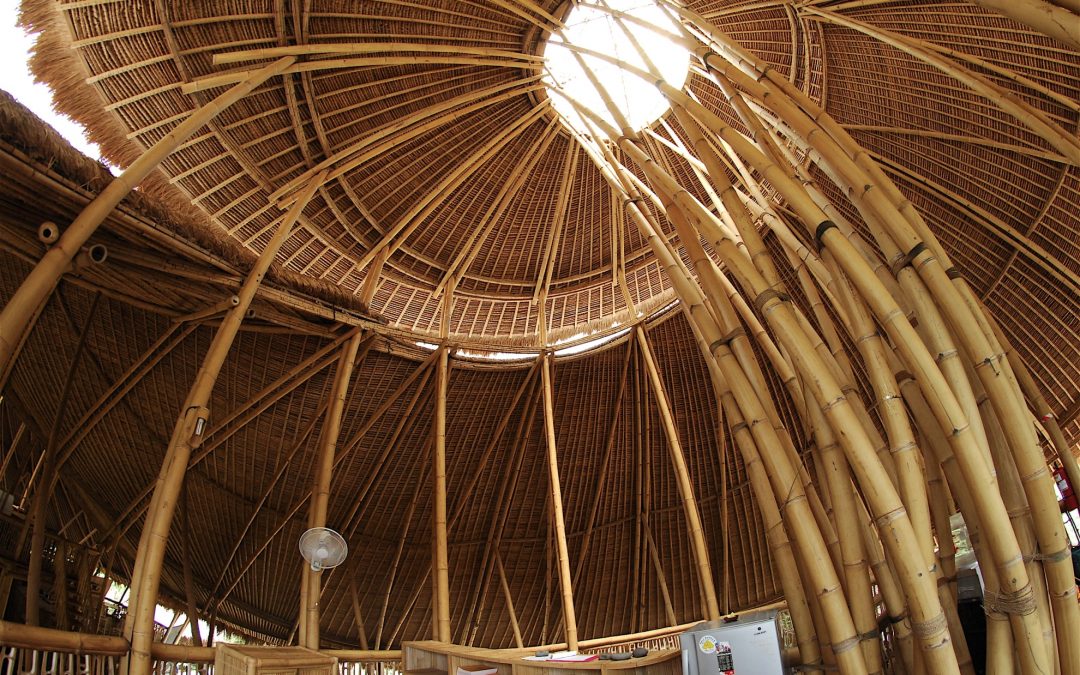Thousands of people come to visit the Green School campus every year, just to see the incredible bamboo architecture. From primary school classrooms that feel more like safe nests for children, to large, fluid, wall-less learning spaces, visitors are captivated by the beautiful designs, which inspire and facilitate the creative learning experience.
Learning can happen anywhere and at any time. But having a home-base, a place to call your own, a home-room that provides a sense of belonging is still important, especially for children. At Green School, no two classrooms are the same. Each one has its own unique features, but all share some common design principles, carefully crafted by artists and engineers (Elora Hardy’s fairytale vision meets robust building with bamboo techniques).
Bamboo embodies Green School’s vision of innovation and sustainability — being strong, light, flexible and renewable.
The buildings on the Green School campus are defined by organic and timeless shapes allied with modern structural design ideas. The 73 magnificent bamboo structures that make up the school are redefining the limits of what a school campus can be. Some of the key bamboo buildings at Green School include the Millenium Bridge, the Heart of School and the Sangkep. All buildings play a key part in the Green School experience and way of learning.
- Millennium Bridge
The charismatic Millennium Bridge whose roof powerfully rises at both ends was created by Ibuku, who designed the roof after Indonesia’s traditional Minang Kabau clan houses. The engineering of the structure presents remarkably new construction techniques pioneered by German carpenter Jörg Stamn.
The ridge, the eaves, and the flooring beams are given their elaborated shapes through the rab-rab technique (consisting of making notches along the long axis to allow for bending) and held together by a dynamic radial rafter truss system.
Relying on their individual properties, the bridge is made of 3 types of bamboo: Petung (Dendrocalamus asper), Tali (Gigantochloa apus) and Duri (Bambusa blumeana).
- Heart of School
The magnificent Heart of School is the centre of the campus. Some may interpret its rising spiral shapes as those of a seashell, while others may feel like they are entering a mighty bamboo volcano whose central interwoven bamboo columns reach 19 meters from ground to sky in the manner of a lava canal.
The double hyperbolic ellipses (originally appearing in Frei Otto’s book on Tensile Structures) glorify the bamboo Petung poles by making use of both their compressive and tensile strengths; while the roof is retained by the pulling forces of the ellipse, the spiral staircase gently sits on its cross bracings.
- Sangkep
Every week, Green School students and teachers gather for Friday assembly in the Sangkep. This is a key highlight of the Green School learning experience. Constructed using a truss system that resembles a bridge, this stadium-like structure is striking, the roof spans over 30 meters and is anchored in two giant river rocks at either end of the building. This engineering prowess relies once again on the tensile strength of the bamboo to create a dramatic span.
More than being just about beauty and sustainability, the bamboo buildings at Green School create a space for magical things to happen.
Bamboo helps people reconnect with nature; it also allows them to reconnect with who they are.
This is a big part of what makes Green School such an incredible learning environment, and it is capturing the imaginations of designers, entrepreneurs and architects from around the world.
To design with bamboo pushes us to engage in conversation with the material.
It teaches us to listen to what it is asking for, how it wishes to be used. Like all of us, it wants to be respected and calls for a purpose that will glorify its strengths and embrace its unique profile.
It is not nature’s role to adapt to our designs, but it’s our designs that should respond to respect the nature of the materials we use.
If you are interested in building with Bamboo, the next Bamboo U(niversity) course is coming in April 2018!
You will receive a matchless opportunity to experiment and engage with bamboo, from harvesting to preservation, from design to construction.
The course is hosted by The Kul Kul Farm in collaboration with Ibuku. It’s a chance to go on a 10-day journey from theory to practice, from abstract to tangible. Join the Bamboo design conversation. More info at The Kul Kul Farm website or bit.ly/1bxkfyF.
Article by: Orin Hardy, Co-Founder of The Kul Kul Farm, Landscape Designer, and Educator. After studying permaculture and graduating from the Evergreen State College in Olympia Washington, he returned to Bali in 2012 and started implementing regenerative food systems through The Kul Kul Farm and exploring its relationship to people and communities.





